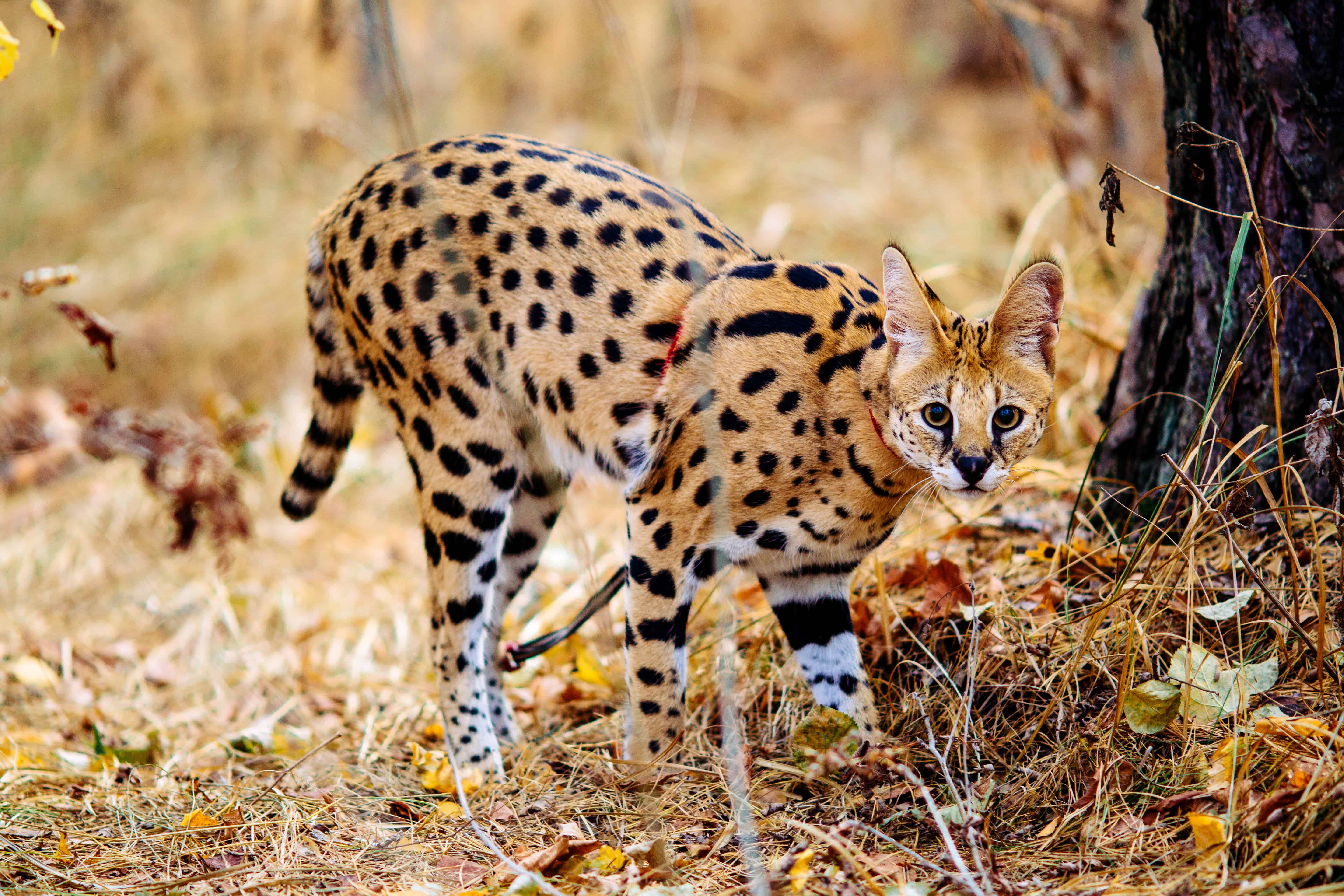Africa is home to an incredible variety of wildlife, including many species of cats. Ten large and small types inhabit the continent, from majestic lions and cheetahs to smaller wildcats such as caracals and servals. These remarkable creatures have adapted to a range of habitats in Africa, from dense forests to dry grasslands and deserts. Other animals found across the continent include elephants, rhinos, antelopes, hippos, zebras, giraffes, baboons, and monkeys—all fascinating African wildlife that can be seen in their natural habitats throughout the region.
10 Types of African Cats
The many felines of the animal kingdom are all similar in their solitary, predatory nature. From lions to house cats, they are all obligate carnivores specializing in hunting and feasting on prey. Each species of cat is distinct and gorgeous in its way. Here are some of the most wonderful large and small cats in Africa.
African Lion
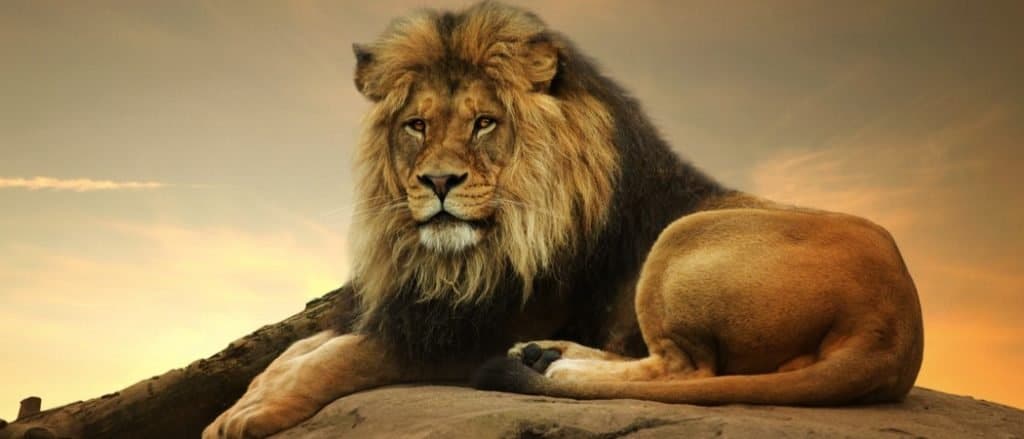
African lions are strong predators who hunt using stealth and strength – usually targeting large game such as antelopes, zebras, and
buffalo
.
©St. Nick/Shutterstock.com
The African Lion is the biggest of all of the cats found in Africa, and, as a result, it is also known as the King of Beasts. The males are easily identifiable with their thick manes that can range from blond to black. With an average lifespan of 10-14 years in the wild, these majestic animals can grow up to 400 pounds and measure up to 8 feet long! They are strong predators who hunt using stealth and strength – usually targeting large game such as antelopes, zebras, and buffalo. Lions live together within prides which consist of several female lions, cubs, and one or more male lions who protect them from danger.
Leopard

To protect themselves from danger, leopards will climb trees or hide in dense vegetation when necessary.
©Rudi Hulshof/Shutterstock.com
African leopards are one of the most iconic animals in Africa. They have an unmistakable spotted coat, long legs and tails, and powerful jaws that make them efficient hunters. Leopards are mainly nocturnal creatures that live solitary lives in their natural habitats, like savanna grasslands, forests, mountains, and deserts. They feed on a variety of prey, including small mammals such as hares, rodents, antelopes, and birds. In some areas, they may also scavenge for carrion or kill livestock, which can cause conflicts with local people who rely on these animals for food or income from tourism. To protect themselves from danger, leopards will climb trees or hide in dense vegetation when necessary to stay safe from predators or humans hunting them illegally for their skins or other body parts used for traditional medicines and ceremonies.
Cheetah

Cheetahs are solitary animals and usually hunt alone during the day to take advantage of their sharp vision.
©Stu Porter/Shutterstock.com
The African Cheetah is a large and powerful cat that can be found throughout sub-Saharan Africa. It is known for being the fastest land mammal, with speeds reaching up to 75 mph! It has an array of unique physical features such as its long legs, deep chest, small head, black tear-like stripes running from the eyes down the sides of its nose, and its distinctive spotted coat. The cheetah is also one of the few cats that have non-retractable claws, which help them grip onto surfaces when running at high speeds.
Cheetahs are solitary animals and usually hunt alone during the day to take advantage of their sharp vision. They usually prey on smaller mammals like gazelles, impalas, and hares but will also eat birds if necessary. Unfortunately, due to increased habitat destruction, hunting for the fur trade, and competition with other predators, cheetahs are listed as vulnerable by the IUCN Red List of Threatened Species.
African Golden Cat

The African Golden Cat is a medium-sized wildcat that is native to the tropical rainforests of central and western Africa. It has distinctively golden brown fur with spots, stripes, and streaks of black on its body. This cat can reach up to 3 feet in length and weigh between 15-32 pounds when fully grown. As an ambush predator, it relies heavily upon its camouflaged coat for hunting small mammals like rodents, monkeys, antelopes, birds, and reptiles. It will also occasionally feed on carrion or scavenge from other predators’ kills if food becomes scarce. The African Golden Cat tends to be solitary, but some pairs have been spotted together during mating periods in certain regions. Females typically give birth to one or two cubs after a gestation period of around 70 days. However, litters as large as four kittens have been recorded at times too!
Serval
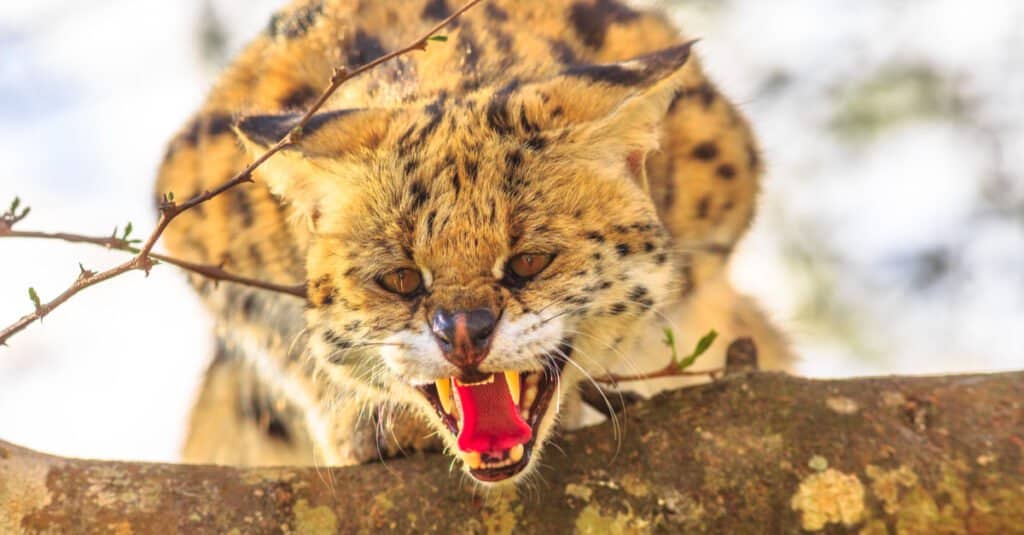
Servals are active throughout the day but mainly hunt at night for their prey, using their excellent hearing skills to locate them in the dark.
©Benny Marty/Shutterstock.com
The African serval is a medium-sized wild cat native to the grasslands and savannas of Africa. It has a slender body with long legs, large ears, and a short tail. The fur color can range from yellowish gray to reddish brown, with black stripes on its neck and back. The serval also has distinctive black spots along its sides and flanks that help it blend into the tall grasses where it lives. Its diet consists primarily of small rodents such as mice, rats, birds, lizards, frogs, and insects.
Servals are active throughout the day but mainly hunt at night for their prey, using their excellent hearing skills to locate them in the dark. They have been known to leap up to 9 feet high in pursuit of birds or other animals! Servals are solitary creatures who rarely interact with other cats unless during mating season when males search for females by following trails, they leave behind through scent marking.
Caracal
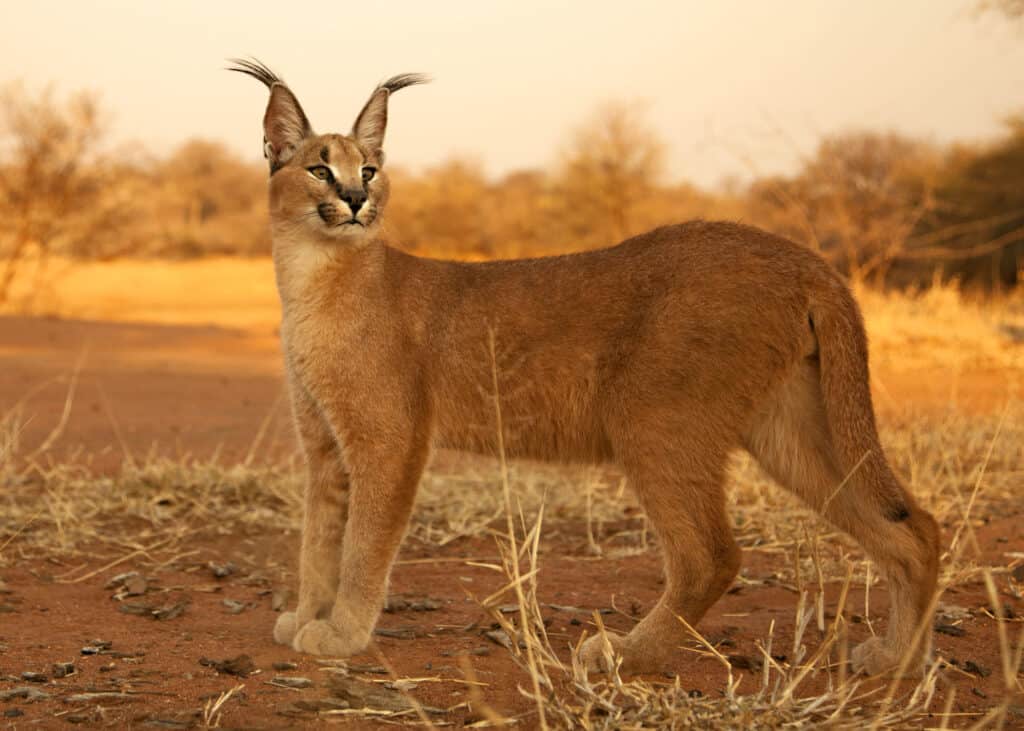
Though caracals live mostly in remote areas away from humans, they are still threatened by habitat destruction.
©iStock.com/MarieHolding
The African caracal is a large wildcat that is native to Africa, the Middle East, and Central Asia. It has distinctive long tufts of hair on its ears and a reddish-brown coat with black markings. Its name comes from the Turkish word for “black ear” due to its tufted ears.
Caracals are solitary animals who hunt during the night, primarily feeding on small mammals such as rodents, birds, and hares. They have been known to take down larger prey, such as antelopes, in some cases! Caracals also love to climb trees, often using them as vantage points from which they can spot their prey below.
Though caracals live mostly in remote areas away from humans, they are still threatened by habitat destruction caused by human development activities like farming or urbanization. Conservation efforts should continue so that these beautiful cats can remain part of our planet’s diverse wildlife population for years to come!
Jungle Cat

As solitary animals, they usually only come together during the breeding season.
©Andrew M. Allport/Shutterstock.com
The African jungle cat (Felis chaus) is a medium-sized wildcat native to Africa, Southwest and Central Asia, and the Sinai Peninsula. It has short reddish-brown fur with spots on its sides and stripes on its head. Its legs are long in comparison to other cats of similar size, giving it an agile gait as it moves through dense vegetation such as grasslands or thickets. The average weight for males is 8–11 lbs, while females typically weigh in at 6–9 lbs. These cats typically hunt small rodents, including rats and mice but may also take larger prey, such as hares or birds, when available. They are mostly active during the day and spend their nights sleeping in dens made from tall grasses or hollow trees. As solitary animals, they usually only come together during the breeding season, which occurs once a year between April and June.
African Wildcat
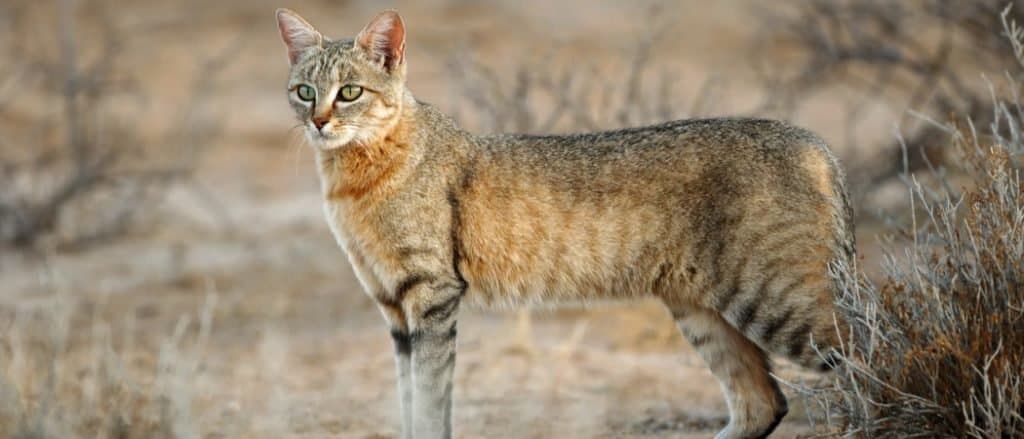
These cats mainly feed on small rodents like mice or gerbils.
©EcoPrint/Shutterstock.com
The African Wildcat, scientifically named Felis silvestris lybica, is a small wildcat native to Africa and areas of the Middle East. It is closely related to the common housecat and can interbreed with it, although it has a much more slender body and shorter legs than its domesticated counterpart. The African Wildcat typically has tawny gray fur that may have stripes or spots in some cases, along with white markings on its face, belly, and feet. They have large ears that help them detect prey in grasslands, savannas, and deserts.
African Wildcats are solitary animals who live in dens made of rocks or bushes near water sources such as rivers or streams – they prefer areas where there is plenty of cover for hiding from predators like lions, hyenas, and leopards. These cats mainly feed on small rodents like mice or gerbils but occasionally supplement their diet by hunting larger animals such as hares or antelope calves if necessary.
Sand Cat
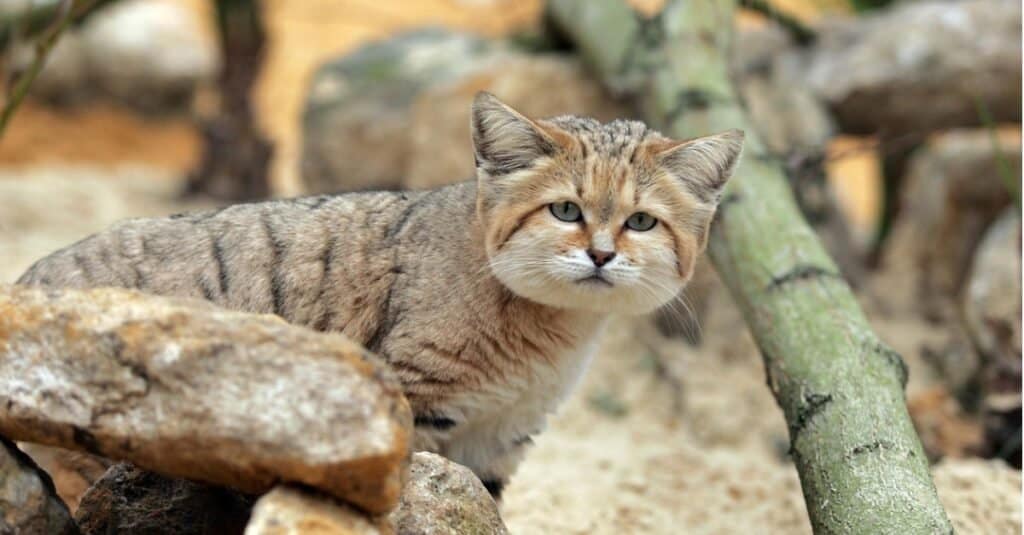
Sand Cat, Felis margarita, amount stones. These wild cats look like cute, cuddly domestic cats, but it thrives in a harsh desert habitat.
©iStock.com/slowmotiongli
The African sand cat (Felis margarita) is a small wildcat in the deserts of northern Africa and the Arabian Peninsula. It has a light sandy-gray coat to help it blend into its environment, as well as thick fur on its feet to protect them from the hot sand. Its ears are large for better hearing, and it has prominent eyes for better night vision and to detect movement in its desert habitat. The tail is short but broad at the base, with black markings along both sides that fade away toward the tip.
The African sand cat mainly eats small rodents like gerbils, jerboas, lizards, and insects like locusts and grasshoppers which they hunt in their arid habitats during twilight or nighttime hours when it’s cooler outside. They also get moisture from their prey, as they don’t need to drink water very often because of their adaptation to living in dry environments with limited resources.
Black-footed Cat
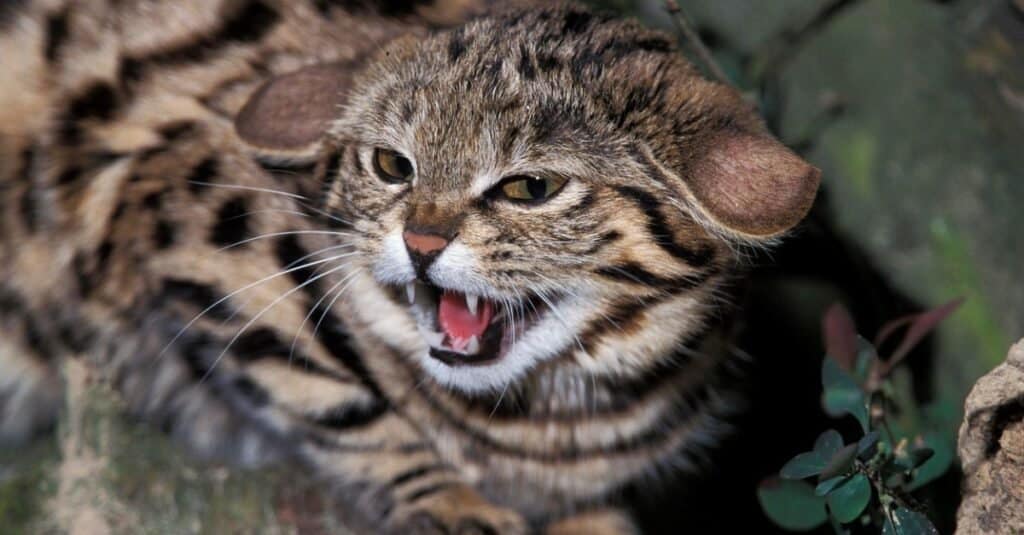
The black-Footed cat snarls in a defensive posture, showing why this is one of the scariest cats.
©iStock.com/slowmotiongli
The African black-footed cat is a small wildcat native to the arid regions of South Africa, Namibia, Botswana, and Angola. It is one of the smallest cats in the world, measuring only 15–20 inches long with an average weight of 3.3 pounds. The cat has short legs and a wide head with large ears, which gives it excellent hearing capabilities. Its fur color varies from sandy brown to dark gray or reddish brown, and its belly is white or yellowish-cream colored, while its feet are uniformly black, giving it its name. This species displays both diurnal and nocturnal behavior as they hunt mainly rodents but also feed on birds, lizards, insects, and other small mammals. They are solitary animals except during breeding season when males will compete for a female’s attention by displaying their vocalization prowess, among other things!
Why Cats Matter
The ten cats of Africa play a vital role in maintaining the balance of their ecosystems. They help to regulate populations of smaller animals, such as rodents and reptiles, which can otherwise become overpopulated and cause problems for other species. In addition, they are important predators that keep larger animal populations in check as well. This helps to prevent overcrowding and preserve diversity within the ecosystem. Furthermore, these cats also contribute to nutrient cycling by consuming prey animals that would otherwise die off or decompose without being in use by other organisms.
Finally, African cats serve an important function as an umbrella species. Protecting areas where they live often extends protection to many other species living in the same environment due to conservation efforts made on behalf of the cat population. Altogether, these diverse roles make African cats crucially important to preserving biodiversity and healthy ecological systems across Africa’s varied landscapes.
Thank you for reading! Have some feedback for us? Contact the AZ Animals editorial team.

